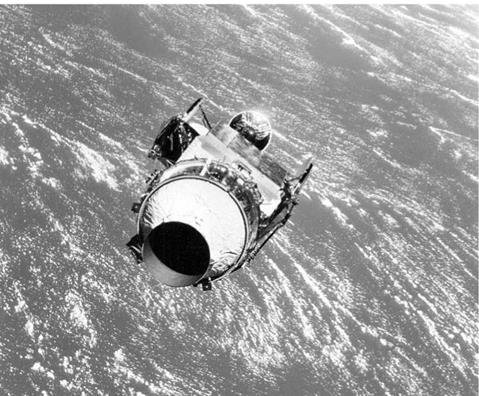STS-51
|
Int. Designation |
1993-058A |
|
Launched |
12 September 1993 |
|
Launch Site |
Pad 39B, Kennedy Space Center, Florida |
|
Landed |
22 September 1993 |
|
Landing Site |
Runway 15, Shuttle Landing Facility, Kennedy Space Center, Florida |
|
Launch Vehicle |
OV-103 Discovery/ET-59/SRB BI-060/SSME #1 2031; #2 2034; #3 2032 |
|
Duration |
9 days 20 hrs 11 min 11 sec |
|
Call sign |
Discovery |
|
Objective |
Deployment of the Advanced Communication Technology Satellite (ACTS); deployment and retrieval of the Orbiting and Retrieval Far and Extreme UV Spectrograph-Shuttle Pallet Satellite (ORFEUS-SPAS); EVA procedures and demonstration test |
Flight Crew
CULBERTSON Jr., Frank Lee, 44, USN, commander, 2nd mission Previous mission: STS-38 (1990)
READDY, William Francis, civilian, pilot, 2nd mission Previous mission: STS-42 (1992)
NEWMAN, James Hansen, 36, civilian, mission specialist 1 BURSCH, Daniel Wheeler, 36, USN, mission specialist 2 WALZ, Carl Erwin, 38, USAF, mission specialist 3
Flight Log
The original launch attempt on 17 July was scrubbed during the T — 20 minute hold due to premature and unexplained charging of pyrotechnic initiator controllers on the LH vent arm umbilical and the SRB hold-down bolts. The problem was traced to a faulty control card on the Mobile Launch Platform (MLP). After an abbreviated countdown which commenced on 23 July, the 24 July launch attempt was halted at T — 19 seconds due to problems with the APU turbine assembly in one of the two hydraulic power units on the right SRB. The APUs were replaced on the pad. The launch was rescheduled for 4 August and again for 12 August because of concerns over the Perseid meteor shower which was due to peak on 11 August. The 12 August attempt was aborted at the T — 3 second mark due to a faulty sensor which was monitoring fuel flow on SSME #2. This resulted in the fourth pad abort in the programme and the second of 1993. All three engines were subsequently changed out on the pad. The launch was then scheduled for 10 September, but following loss of
|
The ACTS satellite, with its attached TOS upper stage, is shown following release from Discovery, completing the first major objective of the mission |
communications with the Mars Observer spacecraft and the NOAA-123 satellite, NASA slipped the launch 48 hours in order to review the design, production and testing of ACTS prior to committing it to launch and deployment.
The ACTS was successfully deployed during FD 1 and, some 45 minutes after leaving the payload bay of Discovery, the TOS was fired to take the satellite towards its geostationary operational orbit. The second deployment of the mission came on FD 2, when ORFEUS-SPAS was released by RMS for six days of independent data collection, the first of a planned series of ASTRO-SPAS missions. The SPAS also carried the IMAX camera, which recorded spectacular images of Discovery flying in orbit both during release and recapture of the pallet satellite.
As ACTS was being checked out in its geosynchronous orbit and ORFEUS was away gathering data, the crew of Discovery settled down to their own science programme of payload bay and mid-deck experiments. These included the exposure to space of selected materials for a short duration, protein crystal growth, chromosome and plant cell division, high-resolution Shuttle glow spectrograph photography of the aurora, an investigation into polymer membranes processing, further calibration of the Air Force Maui Optical Site and radiation monitoring inside the crew compartment. The crew also continued the programme of Earth resources and phenomena observations.
On FD 5 (16 Sep), Walz (EV1) and Newman (EV2) performed the third and final generic EVA (7 hours 5 minutes) to evaluate tools, tethers, foot restraints and mobility. Part of this programme was connected to the forthcoming Hubble Service Mission manifested for STS-61. This time the RMS was not used to support the EVA, because it was needed later in the flight to retrieve ORFEUS-SPAS. This also provided a “minimum equipment scenario”, with the crew making optimum use of materials already aboard for other purposes. This could prove essential for a mission requiring EVA where no RMS was available.
The landing of STS-51 on 21 September was called off due to the possibility of rain showers within 48 km of the SLF. Discovery eventually came home to the first end-of – mission night landing at the Cape.
Milestones
163rd manned space flight
87th US manned space flight
57th Shuttle mission
17th flight of Discovery
28th US and 52nd flight with EVA operations
1st use of Transfer Orbit Stage
1st end of mission night landing at KSC
3rd and final test and demonstration EVA











